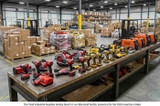Essential Workshop Layout Tips: Organizing Your Tools for Maximum Efficiency
Key Takeaway
The key to an efficient workshop lies in thoughtful organization, strategic tools placement, and a layout that complements your workflow. By implementing zones for different activities, utilizing vertical space, keeping frequently used tools accessible, and maintaining a clean, well-lit environment, you can significantly boost your productivity and enjoyment of your projects. Remember, the perfect workshop layout is one that evolves with your needs and working style.
Introduction
A well-organized workshop is the foundation of productive and enjoyable project work, whether you're a DIY enthusiast or a professional craftsperson. An efficient layout not only saves time but also enhances safety and creativity. An organized workshop is the backbone of any efficient project, where every tool has its place and every movement is purposeful. The key to maximizing efficiency lies in creating a layout that not only saves time but also minimizes unnecessary steps.
One essential tip for achieving this is to group your tools according to the tasks they perform most frequently. By organizing tools in dedicated zones—such as cutting, assembly, and finishing—you can streamline your workflow, reduce clutter, and ensure that everything you need is always within easy reach. This thoughtful arrangement is the first step towards transforming your workspace into a model of productivity and precision.
In this article, we'll dive into the Essential Workshop Layout Tips, focusing on how to organize your tools for maximum efficiency. A well-organized workshop not only enhances productivity but also ensures safety and ease of access, allowing you to work smarter, not harder. Whether you're setting up a new workspace or optimizing an existing one, these tips will help you create a layout that supports your workflow and keeps your tools at your fingertips.
Understanding Workflow and Zones
Before reorganizing your workshop, take time to analyze your workflow:
- Identify common projects and tasks
- Note the sequence of operations for these tasks
- Observe your movement patterns within the space
Creating Functional Zones
Divide your workshop into distinct zones based on activities:
- Cutting Zone
- Assembly Zone
- Finishing Zone
- Storage Zone
- Planning/Design Zone
The Best Ways to Maximize Space
1. Vertical Storage Solutions
Make use of wall space for efficient storage:
- Pegboards for hand tools
- Magnetic strips for metal tools
- Wall-mounted shelves for larger items
- Ceiling storage for long materials or seasonal items
2. Mobile Workstations and Tool Carts
Incorporate mobility for flexibility:
- Rolling workbenches
- Mobile tool carts
- Collapsible or fold-away work surfaces
3. Multi-functional Furniture
Choose furniture that serves multiple purposes:
- Workbenches with built-in storage
- Flip-top tool stands
- Adjustable height tables
Tips for Strategic Tool Organization
1. The "First In, First Out" Principle
Organize tools based on frequency of use:
- Keep frequently used tools at waist level
- Store less-used items higher or lower
- Consider shadow boards for visual organization
2. Tool Storage Systems
Invest in efficient storage solutions:
- Modular drawer systems
- Custom foam inserts for drawers
- Labeled bins and containers
3. Power Tool Stations
Create dedicated areas for stationary power tools:
- Ensure adequate clearance around each tool
- Plan for dust collection
- Consider power supply and extension cord management
Tips for Lighting and Visibility within the workshop
1.Natural Light
Maximize natural light where possible:
- Position workbenches near windows
- Use light-colored walls to reflect light
- Consider skylights or light tubes for windowless spaces
2. Task Lighting
Implement targeted lighting for detailed work:
- Adjustable arm lamps for workbenches
- Under-cabinet LED strips
- Magnetic base lights for machine tools
3. Overhead Lighting
Ensure even, shadow-free general lighting:
- LED shop lights for energy efficiency
- Consider color temperature (4000K-5000K for workspaces)
- Plan for even light distribution across the workshop
Safety and Comfort Considerations for Workshop efficiency
1. Safety Stations
Designate areas for safety equipment:
- First aid station
- Fire extinguisher location
- Eye wash station (if applicable)
2. Ergonomic Considerations
Design your space with comfort in mind:
- Adjustable height workbenches
- Anti-fatigue mats in standing areas
- Proper ventilation system
3. Clear Pathways
Ensure easy movement throughout the workshop:
- Maintain clear walkways
- Consider flow between workstations
- Plan for material handling and transport
Dust Management and Cleanliness
1. Central Dust Collection System
Invest in effective dust management:
- Central dust collector with ductwork
- Consider air filtration systems
- Plan tool placement around dust collection points
2. Cleaning Stations
Incorporate cleaning into your layout:
- Designated area for brooms, dustpans, and vacuums
- Easy access to trash and recycling bins
- Consider a wash station for paint brushes and hands
Electrical Planning for maximum workshop efficiency
1. Power Distribution
Plan for adequate and safe power supply:
- Multiple circuits for high-draw tools
- Strategically placed outlets
- Consider ceiling-mounted retractable power cords
2. Charging Stations
Create a dedicated area for charging cordless tools:
- Wall-mounted charging organizers
- Power strip management
- Consider battery storage solutions
Adaptability and Future Growth
1. Modular Systems
Choose systems that can grow with your needs:
- Modular shelving units
- Expandable workbench systems
- Adaptable storage solutions
2. Regular Layout Reviews
Schedule periodic evaluations of your layout:
- Assess efficiency quarterly
- Make adjustments based on new tools or projects
- Be open to major reorganizations as needed
Frequently Asked Questions
Q: How often should I reassess my workshop layout?
A: It's a good idea to evaluate your layout every 3-6 months or whenever you acquire new tools or take on different types of projects. Small adjustments can be made continuously.
1: What's the most important factor in workshop organization?
A: Workflow efficiency is crucial. Organize your space based on how you actually work, keeping frequently used tools and materials easily accessible.
2: How can I maximize space in a small workshop?
A: Utilize vertical space with wall storage, opt for multi-functional and mobile furniture, and consider fold-away or collapsible work surfaces.
3: Is it worth investing in a central dust collection system?
A: For woodworkers or anyone generating significant dust, a central dust collection system is a worthwhile investment for both health and cleanliness.
4: How do I decide where to place my large, stationary power tools?
A: Consider your workflow, power requirements, dust collection needs, and ensure adequate clearance around each tool for safety and material handling.
Related Articles
Workshop Organization: Practical Tips and Creative Ideas for Maximizing Space and Accessibility
Best Workshop Organization Tips for Small Spaces
Conclusion
Creating an efficient workshop layout is an ongoing process that requires thoughtful planning and regular refinement. By focusing on workflow, maximizing space utilization, organizing tools strategically, and prioritizing safety and comfort, you can create a workshop that not only boosts your productivity but also enhances your enjoyment of your craft.
Remember, the perfect workshop layout is one that works for you and adapts to your evolving needs. Don't be afraid to experiment with different arrangements and continuously fine-tune your space. With these essential layout tips, you're well on your way to mastering your workshop and taking your projects to the next level.
Ready to transform your workshop into a model of efficiency? Visit Tend Industrial Supplies for a wide range of workshop organization solutions, from innovative storage systems to ergonomic workbenches. We have everything you need to create the perfect layout for your unique needs.
Need expert advice on optimizing your workshop layout? Our team of seasoned professionals is here to help. Contact us at sales@tendsupplies.com for personalized recommendations and layout planning assistance. Don't let a disorganized workspace hold you back. Invest in your productivity and craft by optimizing your workshop layout today. Shop our selection of workshop solutions and start your journey to a more efficient workspace!









